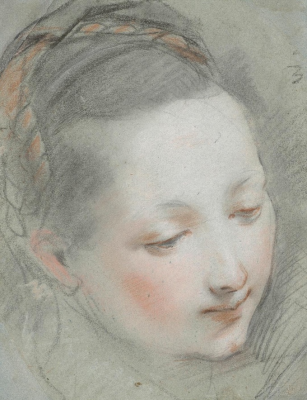Drawing the Italian Renaissance at the King's Gallery

Federico Barocci, Head of the Virgin ©Royal Collection Enterprises Limited 2024, Royal Collection Trust.
'Drawing the Italian Renaissance' is the largest display of drawings from 1450-1600 ever exhibited in the UK. During this period drawing developed from being a workshop practice to an art form. 160 works by over 80 Italian artists including, the great masters, are currently exhibited at the King's Gallery in a stunning show. Some exhibits have never been viewed before.
The Royal Collection has one of the world's greatest collections of Renaissance drawings. They cannot be permanently displayed for conservation reasons. Over thirty are seen in public for the first time and twelve for the first time in the UK.
Charles II acquired two albums of drawings by Leonardo Da Vinci from the Catholic Norfolk family. An unusual drawing made for the court of Francis I, where the artist spent his final years, shows a man in elaborate costume for a theatrical masque.
Amongst the many highlights are astonishing studies of animals by Leonardo including his delightful studies of cats, both domestic and Leonine ,and affectionate and sensitive pen and ink canine depictions by Parmigianino, known for his affinity with dogs. A rare chalk drawing of an ostrich is attributed to Titian has never been seen before in the UK.
The striking 'Head of a Man' by Carmelite friar Filippino Lippi,1496, is a life study for a bystander in his altarpiece of The Adoration of the Magi, in The Uffizi ,Florence, and has never been viewed before.
Fra Angelico's contemplative Bust of a Cleric, c1447-59, in metal point, pen and ink is the oldest drawing displayed. It is a possible study for a fresco of the Life of St. Lawrence in the chapel of Pope Nicholas V at the Vatican.
Gallery I looks at the human body. In 1510 Leonardo spent the winter working alongside a professor of anatomy in Milan's medical school. He even dissected twenty corpses himself and made extraordinarily detailed anatomical drawings
Renaissance artists drew with iron gall ink, a chemical reaction between iron sulphates and a solution of tannins from oak galls.
Some experimented with homemade coloured chalks, notably Federico Barocci. His exquisite Head of the Virgin, c1582 is a delight defined on blue paper. The delicate pinks and whites blended on black chalk give a luminous effect to this charming study for 'The Anunciation' in the Vatican.
Bartolomeo Montagna's 'Head of the Virgin', c1499, in black chalk has an almost contemporary look and is possibly a study for a sculpture.
Gallery 2 focuses on nature. A beautifully drawn lily by Verrocchio ,1475, was originally attributed to Leonardo. It is presumed to be a preparatory drawing for a painting of the Annunciation as a symbol of Mary's purity.
Studies of flowers by Leonardo in pen and ink over red chalk include a Star of Bethlehem and anemones, flowers associated with Mary in Renaissance art and are seen in proliferation in his 'Virgin of the Rocks '.
The final room is themed 'Drawing the Divine'. Michaelangelo's 'The Virgin and Child with St John the Baptist, c1532 could be an independent drawing for a personal subject of devotion or preparation for a sculptural group.
The final studies for Raphael's Acts of the Apostles tapestries and his drawing of the Conversion of the Pro-Consul are important works.. Raphael was one of the few artists to use female models. His stunning The Three Graces is defined with red chalk on white paper c.1517-18 for a fresco at the Villa Farnesina.
A design by Polidoro da Caravaggio for a carved rock crystal to be set in a crucifix for Pope Clement VIII ,depicts The Betrayal of Christ and an unfinished drawing 1530-40, showing an elaborate plan for rebuilding St.Peter's Rome by Sangallo are fascinating .
Three graduates from the Royal Drawing School are present on Mondays, Thursdays and Fridays, drawing copies of the Collection and interact with visitors. The day I visited Sara Lee Roberts, niece of 94 year-old Catholic artist Francis Hoyland, and former teacher at The Royal Drawing School, was on duty. Her work, inspired by the exhibition, is alongside those of Jesse Ajilore and Joshua Pell that can be viewed in a room to the right on exiting the exhibition.
Roberts said: "There's an immediacy with drawings….I hope to make work that has a genuine connection with the original Renaissance drawings but that is thoroughly contemporary and can speak to people today."
A unique innovation is that visitors are encouraged to be creative and draw too. Benches with paper and pencils are provided.
Another welcome approach is the £I charge for those on Universal and Pension Credit making these Treasures of the Royal Collection accessible to all.
Until 9 March 2025 10-5.30 Thursday -Mondays only
Range of Admission charges
Adult £ 19.00
18-24-year-olds £12.00
£1 admission for those on Universal and Pension Credit and other State Benefits
See: www.rct.uk/visit/the-kings-gallery-buckingham-palace


















